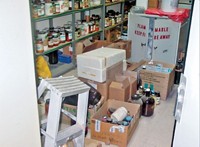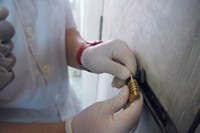Advertisement
Grab your lab coat. Let's get started
Welcome!
Welcome!
Create an account below to get 6 C&EN articles per month, receive newsletters and more - all free.
It seems this is your first time logging in online. Please enter the following information to continue.
As an ACS member you automatically get access to this site. All we need is few more details to create your reading experience.
Not you? Sign in with a different account.
Not you? Sign in with a different account.
ERROR 1
ERROR 1
ERROR 2
ERROR 2
ERROR 2
ERROR 2
ERROR 2
Password and Confirm password must match.
If you have an ACS member number, please enter it here so we can link this account to your membership. (optional)
ERROR 2
ACS values your privacy. By submitting your information, you are gaining access to C&EN and subscribing to our weekly newsletter. We use the information you provide to make your reading experience better, and we will never sell your data to third party members.
Environment
Minimalist Chemistry
Through small-scale experiments, Asian educators increase access to, and safety of, hands-on lab experience
by A. Maureen Rouhi
October 3, 2011
| A version of this story appeared in
Volume 89, Issue 40

In many parts of the world, chemistry students, especially at precollege levels, can’t do lab work because of limited equipment, glassware, reagents, and safe lab space. At the 14th Asian Chemical Congress, held last month in Bangkok, Asian chemical educators demonstrated kits they have designed for experiments at a fraction of the usual scale for traditional lab experiments. When lab exercises are reduced to the smallest possible scale that still effectively demonstrates a principle or a transformation, the educators say, the advantages are multiple: Resources can go further, students can do experiments on their own and are exposed to less hazard, and experiments require shorter times to complete and generate far less waste.
In conference rooms in Bangkok, Kazuko Ogino (left) and Tantayanon (right) demonstrated experiments, and Hiroshi Ogino (center left) and Chek Sotha (center right) teamed up to distill isopropyl alcohol using Tantayanon’s lab kit. Although the Ph.D. chemists and chemistry educators did not wear the usual safety gear during these demonstrations, they emphasize that they require students to follow standard safety practices.
More important is that “in the study of chemistry, actual experience of experiment is important,” said Kazuko Ogino, an emeritus professor of chemistry at Tohoku University, in Japan. According to Ogino, “Confucius said: Tell me and I will forget. Show me and I will remember. Let me do it and I will understand.” Students who think chemistry is uninteresting, difficult to understand, or useless to study could be convinced otherwise, she believes, by hands-on learning made possible by small-scale experiments.
Ogino has designed experiments that students can perform with inexpensive, commercially available plastic multiple-well microplates, vials, syringes, and droppers to explain or demonstrate concepts as varied as electrolysis, separation of organic compounds, and chemical equilibria. At Tohoku University, she noted, the shift to small-scale experiments has yielded 96–99% reductions in the amounts of reagents 1,700 students require for a lab experiment to synthesize isopentyl acetate: acetic acid, from 34 L to 1.4 L; ethanol, from 34 L to 0.8 L, sodium carbonate, from 17 kg to 0.2 kg; and sulfuric acid, from 8.5 L to 0.08 L. For her efforts to develop, promote, and disseminate microscale chemistry and green chemistry education, Ogino received the 2011 Distinguished Contribution to Chemical Education Award of the Federation of Asian Chemical Societies (FACS), which organized the Bangkok congress.
In Bangkok, Ogino performed electrolysis experiments using a 12-well plastic microplate, a 9-V battery, plastic tubing, plastic syringes, sewing pins, and small clamps to connect the pins to a battery. The reagents were table salt, soap solution, pH indicator, food dye, and dilute solutions of sodium sulfate and sodium carbonate. Of these, the most dangerous is sodium carbonate, Ogino noted, adding that the Japanese like to add sodium sulfate to their baths.
To split water, Ogino fills the bulb of a plastic pipette with dilute sodium carbonate. She sets the bulb in one well of a microplate and immerses the pipette’s slender tube in another well filled with soap solution. Then she pierces the bulb with the sewing pins that will serve as electrodes. When she connects the pins to the battery, the soap solution bubbles with the gas produced as water splits: 2H2O → 2H2 + O2.
When she brings a flame near the soap bubbles, a loud pop startles onlookers. The combination of two volumes of H2 and one volume of O2 produced by the electrolysis of water, Ogino explained, is called “detonating gas,” because it explodes upon ignition as the gases reunite to form water.
To measure the volume of gases formed, Ogino repeats the electrolysis in a miniature Hofmann voltameter. The standard-size apparatus to quantify the gases evolved during water electrolysis is “very big and very expensive,” Ogino told C&EN. Her procedure using minipipettes, syringes, and sewing pins supported on a microplate confirms within a minute that H2 and O2 form in a ratio of 2:1, as dictated by the electrolysis reaction.
To show the chemistry at each electrode, Ogino fills one well of a microplate with a dilute solution of sodium sulfate and adds a drop of bromothymol blue pH indicator, which is green at pH 7. Then she inserts a small piece of filter paper in the middle of the well to separate the cathode and anode sections. As the electrolysis proceeds, this time with graphite (pencil lead) electrodes, the liquid in the anode section turns yellow, signaling an acidic solution, due to the half reaction 2H2O → 4H+ + O2 + 4e–. Simultaneously, the liquid in the cathode section turns blue, signaling a basic solution, due to the half reaction 2H2O + 2e– → 2OH– + H2. And when she removes the filter paper and mixes the anode and cathode solutions, the mixture turns green, as the solutions neutralize each other. In less than three minutes, the concepts of half reactions, pH, acidity, and basicity come to life.
And to demonstrate the reactivity of reaction products, Ogino electrolyzes a sodium chloride solution containing a drop of red food dye. Within a few seconds, the color around the anode fades, as the gaseous reaction product bleaches the dye. Ogino invites observers to come close to notice the smell of chlorine gas. “The experiment shows the principle of the chlorine production industry,” she told C&EN. With a few changes in the setup and reagents, she demonstrates the chemistry behind batteries, proving the production of electricity by connecting a device to the circuit. As the reaction proceeds, music plays.
Ogino performed the demonstrations in Bangkok in regular business clothes, without the safety protection that’s standard in traditional chemistry labs; that’s because she knows the experiments very well, she explained. But when students do the experiments, she reassured C&EN, she requires them to wear lab coats and safety glasses.
Similarly, Supawan Tantayanon emphasized that “in the class, we shall follow the rules and regulations” regarding safety. Tantayanon is an associate professor of chemistry at Thailand’s Chulalongkorn University and the president of FACS. At a workshop, she and Zuriati Zakaria, a chemistry professor at Universiti Kebangsaan Malaysia, guided participants in performing organic chemistry experiments with a small lab kit.
Designed by Tantayanon, the lab kit includes flasks, condensers, adapters, and other glassware for synthesis, purification, and various organic chemistry techniques. It also has a multiple-use aluminum heating vessel, an iron stand, clamps, clips, and a thermometer. The components come in a portable, foam-lined wooden case. At the workshop, participants used the kit, a miniature water pump, and an iPhone-sized portable electronic balance to purify naphthalene by sublimation and isopropyl alcohol by distillation and to prepare salicylic acid from drugstore-bought oil of wintergreen (methyl salicylate)—all in a conference room, without fume hoods, gas lines, or water lines. A major advantage of microscale kits is that they can be used safely in places lacking the usual laboratory accoutrements.
What motivated Tantayanon to design the kit was her experience in teaching chemistry labs. “Both students and instructors are at risk due to unavoidable exposure to chemicals,” she told C&EN. “Although we have hoods, we do not have enough for every student. The easy solution is to go small scale. It will reduce the amount of exposure automatically, and if there is an accident, we can cope with it more easily.”
It took Tantayanon two years to design and test the lab kit, which Chulalongkorn University has licensed to U&V Holding (Thailand) Co. Ltd. “For general chemistry experiments, we can find plastic wares, which are available and cheap,” she pointed out. “But not for organic chemistry experiments.”
Both Ogino and Tantayanon say that their small-scale chemistry efforts are well-received by students and teachers. According to Ogino, in 2010 the Japan Society for the Promotion of Science rated her program on microscale chemistry among the top 10 of 240 programs the society supports. And according to Tantayanon, students in Malaysia and Kuwait are using the organic chemistry kit. But neither Ogino nor Tantayanon can say exactly how many students, teachers, and institutions are taking advantage of their educational tools. What’s clear is that because of obvious barriers, only a fraction of those who could use the tools can actually get them.
For Tantayanon’s organic chemistry kit, price is a huge barrier. According to Tantayanon, each kit costs $750, a hefty amount for developing countries. Chek Sotha, president of the Cambodian Chemical Society, wondered how she could raise the money for two kits she would like to bring back to Cambodia.
The plasticware kit for electrochemistry costs only about $100, but it is available only through workshops Ogino conducts. People could gather the components or even get the kit, she pointed out, but without attending a workshop, they wouldn’t know how to make them work. Information is available at the website of the Forum of Microscale Chemistry Laboratory, but only in Japanese. One workshop participant pleaded with Ogino: “Please translate your materials into English.”
The translation may come eventually. Meanwhile, Ogino has more urgent things to do. She comes from Sendai, close to the epicenter of the March 11 earthquake that struck Japan and triggered a devastating tsunami. Because of damage, some schools could not use their laboratories. “As our microscale experiments can be carried out in a classroom without laboratory facilities—such as benches, water, and sinks—some teachers are thinking to replace their chemistry experiments with microscale experiments,” she told C&EN. “I am now working to help them.”




Join the conversation
Contact the reporter
Submit a Letter to the Editor for publication
Engage with us on Twitter